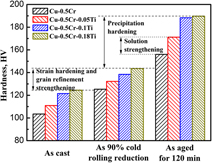Crossref Citations
This article has been cited by the following publications. This list is generated based on data provided by
Crossref.
Zhang, Jianbo
Liu, Yao
Cai, Wei
and
Wang, Hang
2016.
Morphology of Precipitates in Cu-Cr-Ti Alloys: Spherical or Cubic?.
Journal of Electronic Materials,
Vol. 45,
Issue. 10,
p.
4726.
Fu, Huadong
Xu, Sheng
Li, Wei
Xie, Jianxin
Zhao, Hongbin
and
Pan, Zhijun
2017.
Effect of rolling and aging processes on microstructure and properties of Cu-Cr-Zr alloy.
Materials Science and Engineering: A,
Vol. 700,
Issue. ,
p.
107.
Caron, Ronald N.
and
Sharif, Ahmed
2017.
Reference Module in Materials Science and Materials Engineering.
Yuan, Dawei
Wang, Junfeng
Chen, Huiming
Xie, Weibin
Wang, Hang
and
Yang, Bin
2018.
Mechanical properties and microstructural evolution of a Cu–Cr–Ag alloy during thermomechanical treatment.
Materials Science and Technology,
Vol. 34,
Issue. 12,
p.
1433.
Wang, Hang
Gong, Liukui
Liao, Jinfa
Chen, Huiming
Xie, Weibin
and
Yang, Bin
2018.
Retaining meta-stable fcc-Cr phase by restraining nucleation of equilibrium bcc-Cr phase in CuCrZrTi alloys during ageing.
Journal of Alloys and Compounds,
Vol. 749,
Issue. ,
p.
140.
Jinshui, Chen
Bin, Yang
Junfeng, Wang
Xiangpeng, Xiao
Huiming, Chen
and
Hang, Wang
2018.
Effect of different Zr contents on properties and microstructure of Cu-Cr-Zr alloys.
Materials Research Express,
Vol. 5,
Issue. 2,
p.
026515.
Chen, Huiming
Yuan, Dawei
Xie, Weibin
Zhang, Jianbo
Wang, Hang
and
Yang, Bin
2019.
A novel route for strengthening copper rods: Non-solution heat treatment combined with pre-aging.
Journal of Materials Processing Technology,
Vol. 274,
Issue. ,
p.
116290.
Sun, Xinglong
Jie, Jinchuan
Wang, Pengfei
Qin, Bailiang
Ma, Xiaodong
Wang, Tongmin
and
Li, Tingju
2019.
Effects of Co and Si additions and cryogenic rolling on structure and properties of Cu–Cr alloys.
Materials Science and Engineering: A,
Vol. 740-741,
Issue. ,
p.
165.
Wei, Huan
Dai, Xinyu
Han, Pengju
Zhou, Caizhi
Wei, Yinghui
and
Hou, Lifeng
2019.
Age hardening studies of a Cu–4Ti–Cr–Fe alloy.
Materials Science and Technology,
Vol. 35,
Issue. 15,
p.
1848.
Sun, Xinglong
Jie, Jinchuan
Wang, Tongmin
and
Li, Tingju
2020.
Precipitate phase transformation behavior, microstructure, and properties of Cu–Cr–Co–Si alloy.
Journal of Materials Research,
Vol. 35,
Issue. 6,
p.
623.
Huang, Shiha
Huang, Wei
Xie, Weibin
Chen, Huiming
Wang, Hang
and
Yang, Bin
2020.
Microstructure and strengthening mechanisms of CuCrZr alloy by two-step thermomechanical treatment.
Journal of Materials Science: Materials in Electronics,
Vol. 31,
Issue. 20,
p.
17798.
Ma, Muzhi
Li, Zhou
Xiao, Zhu
Zhu, Hanrui
Zhang, Xi
and
Zhao, Fenyan
2020.
Microstructure and properties of a novel Cu-Cr-Yb alloy with high strength, high electrical conductivity and good softening resistance.
Materials Science and Engineering: A,
Vol. 795,
Issue. ,
p.
140001.
Cho, Chang-Hee
Shin, Jesik
Kim, Dongearn
and
Cho, Hoon
2020.
Influence of Addition of Al and Ti Solutes and Variable Processing Conditions on Mechanical and Electrical Properties of Cu-Cr Alloys.
Metals,
Vol. 11,
Issue. 1,
p.
39.
Luo, Zeyu
Luo, Fuxin
Xie, Weibin
Chen, Huiming
Wang, Hang
and
Yang, Bin
2020.
The Effect of Precipitation Characteristics on Hardening Behavior in Cu–Cr–Sn Alloy with Sn Variation.
Powder Metallurgy and Metal Ceramics,
Vol. 58,
Issue. 11-12,
p.
657.
Yang, X. H.
Wang, C. D.
Yang, L.
Zou, J. T.
Xiao, P.
and
Liang, S. H.
2020.
Effects of Nb Addition and Different Cooling Methods on Microstructures and Properties of Cu-Cr Alloys.
Journal of Materials Engineering and Performance,
Vol. 29,
Issue. 8,
p.
5008.
Huang, Zhaokuo
Shi, Renhai
Xiao, Xingyu
Fu, Huadong
Chen, Qing
and
Xie, Jianxin
2021.
Mechanism investigation on high-performance Cu-Cr-Ti alloy via integrated computational materials engineering.
Materials Today Communications,
Vol. 27,
Issue. ,
p.
102378.
Zeng, Hao
Sui, Han
Wu, Shanjiang
Liu, Jinping
Wang, Hang
Zhang, Jianbo
and
Yang, Bin
2021.
Evolution of the microstructure and properties of a Cu–Cr-(Mg) Alloy upon thermomechanical treatment.
Journal of Alloys and Compounds,
Vol. 857,
Issue. ,
p.
157582.
Li, Jiazhi
Ding, Hua
and
Li, Baomian
2021.
Study on the variation of properties of Cu–Cr–Zr alloy by different rolling and aging sequence.
Materials Science and Engineering: A,
Vol. 802,
Issue. ,
p.
140413.
Zhang, Ke
Yang, Jingjing
Li, Jiayao
Chen, Xiaohong
Zhou, Honglei
and
Liu, Ping
2021.
Effect of deformation and aging treatment on the microstructure and properties of Cu-0.45Cr-0.14Ti (wt.%) alloy.
Journal of Alloys and Compounds,
Vol. 851,
Issue. ,
p.
156776.
Sun, Xinglong
Jie, Jinchuan
Wang, Tongmin
and
Li, Tingju
2021.
Effect of two-step cryorolling and aging on mechanical and electrical properties of a Cu–Cr–Ni–Si alloy for lead frames applications.
Materials Science and Engineering: A,
Vol. 809,
Issue. ,
p.
140521.



